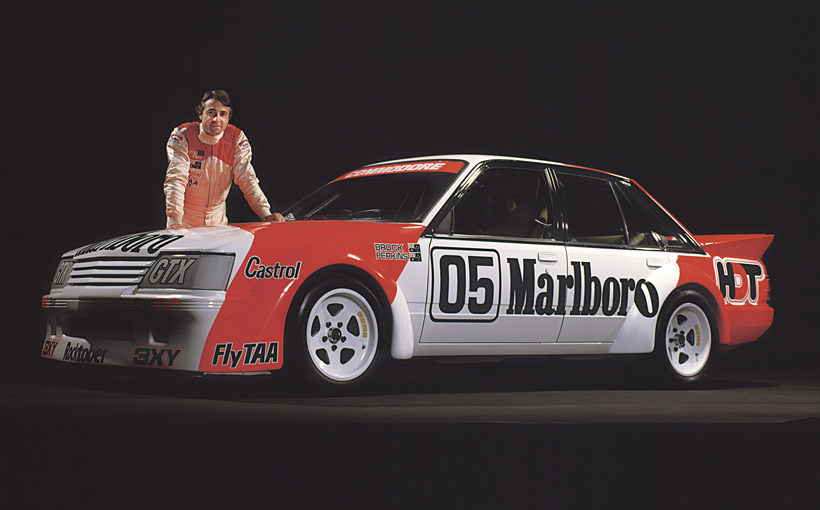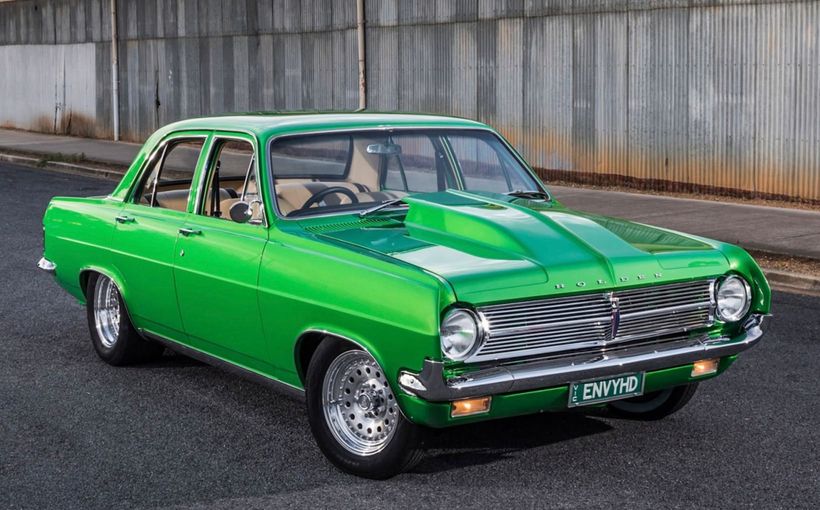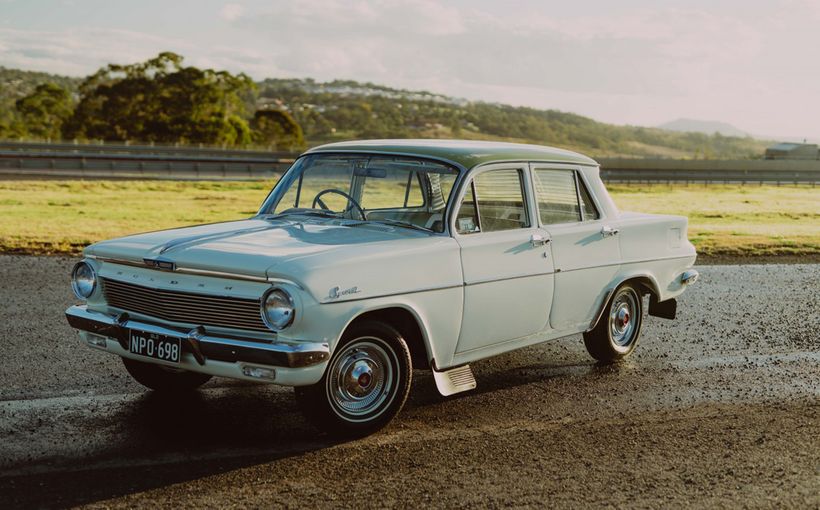Holden VK Commodore: Last Big Banger. First Euro Challenger.

The VK Commodore is the only Holden to have won the Bathurst 1000 under two different sets of rules. This unique achievement in the 1980s cemented the VK’s status as one of the most adaptable and effective race cars in the roaring lion’s proud history at Mount Panorama.
The first came in 1984 which was the last year that our home-grown Group C touring cars competed in Australia’s greatest motor race since the category’s inception in 1973.
That famous win for Peter Brock and Larry Perkins in their Marlboro-backed 'day-glo' VK remains an indelible memory for many race fans, as HDT orchestrated its first 1-2 formation finish with the team’s second car shared by John Harvey and David Parsons. Holden affectionately called those final VKs “The last of the Big Bangers”.

The second win came two years later when the race was being run to international Group A rules. After a difficult start in 1985, Holden and HDT responded with its first purpose-built Group A contender - the SS Group A - which Allan Grice and Graeme Bailey drove to a well-deserved and popular Bathurst win in 1986.
Their privately-entered Commodore, backed by Bailey’s ‘Chickadee’ poultry business, embodied all the lessons learned in Europe that year which allowed them to outclass some quality competition. It was also a long-awaited first Bathurst win for Grice and Bailey.

1984 VK Commodore: The Definitive Group C Touring Car
The 1984 HDT VKs were the simplest, lightest and fastest Group C Commodores produced by Holden’s factory team. After building its first VB Commodore in 1980 HDT refined this process over the next three years with the VC and VH models, resulting in the final VK being the peerless version of the breed.
From 1982 to 1984, Larry Perkins was not only Peter Brock’s co-driver in the big Sandown and Bathurst endurance races each year. He also served as HDT’s workshop manager and ran a typically tight ship. The two Group C VKs had the Perkins Engineering stamp of frugal efficiency all over them. No thread bolt too long. No wire too thick. Minimisation was the buzzword.
They started life as bare body-shells fresh from Holden’s Dandenong assembly plant in Melbourne. Perkins had personally walked them down the line to ensure they avoided the usual road car body sealants, anti-drum compounds and unnecessary brackets to save weight, but received double the number of spot welds and special front sub-frames stamped from thicker steel to better withstand the stresses of racing.

Fabrication work carried out by HDT included seam welding, stronger mountings for suspension components and modification of the standard boot floors to accommodate the big 120-litre ‘dry break’ fuel tanks.
The radius of each wheel arch was also enlarged and the inner halves of the standard rear wheel housings moved slightly inboard to provide enough clearance for the big racing tyres. Even so, these Group C cars never strayed too far from their showroom origins.
The VK’s aerodynamic fiberglass body kit comprising a front spoiler, rear spoiler and wheel flares was the most aggressive - yet smoothest - ever seen on a Commodore Group C racer, thanks largely to Holden’s switch from steel to polycarbonate front and rear bumpers on the VK road cars.

This allowed Holden and HDT to develop a new rear bar moulding and a big front spoiler which for the first time incorporated the bumper in one smooth component. The bulging wheel arch flares and three-piece rear ‘ducktail’ spoiler were effectively carried over from the VH.
It’s arguable that these visual changes would not have been so appreciated if not for the HDT’s switch from its traditional solid Marlboro red to dazzling day-glo red for the 1984 cars. This was done at the insistence of Peter Brock, who had first seen this eye-catching paint treatment on Marlboro-backed race cars in Europe earlier that year.
Mechanically much of the previous VH model’s racing hardware carried over including the Borg Warner Super T10 four-speed gearbox, production-based MacPherson strut front suspension, coil-spring 10-bolt Salisbury live rear axle assembly with Watts linkage and Detroit Locker centre, Bilstein gas front strut inserts and rear shocks, plus big ventilated disc brakes on each corner. Wheels were super lightweight Momo magnesium alloys; 16 x 11-inch fronts with 11.25-inch wide tyres and 16 x 12-inch rears wearing even fatter 13-inch rubber.

Beneath the bonnet of every Group C racing Commodore from the first VB to the last VK was Holden’s mighty home-grown 308cid (5044cc) cast iron, pushrod, carby-fed V8. Prior to that it had also powered the Torana L34 and A9X, so by 1984 this remarkable production-based engine had a decade of racing development behind it.
Simple by today’s standards but state-of-the-art for their time, the VK engines hand-built by HDT engine man Neil Burns produced just over 400bhp (300kW) at 6800rpm and 385 ft/lbs of torque at 4800rpm.
As a result those 1250kg Commodores had formidable power-to-weight ratios. According to Perkins, with the 3.08:1 Bathurst diff the engines were reaching 6600rpm in top gear at the end of the old Conrod Straight which equated to a top speed of 280-290km/h. That’s just as fast as the V8 Supercars of today!

The two HDT VKs proved unbeatable in the three championship events they contested in 1984. Brock and Perkins won the Sandown 400 at a canter, finishing one lap ahead of the Moffat/Hansford Mazda RX-7 and two laps ahead of Harvey and Parsons in the second HDT car.
Three weeks later at Bathurst, Brock just got pipped for pole position by George Fury’s turbocharged Nissan Bluebird before he and Perkins raced away to another dominant victory two laps ahead of their team-mates. Brock slowed right down in the final stages to allow Parsons to catch up and stage the memorable 1-2 formation finish.
Their final AEC appearance was in the Surfers Paradise 300 in Queensland in which Brock had a great duel with Moffat’s RX-7 for the lead before powering home to another win, with Harvey finishing sixth. They will always be two of Holden’s most memorable and admired competition cars.

1986 VK Commodore: First of the Group A Challengers
Aussie touring car racing switched from home-grown Group C to international Group A in 1985. The new rules required that a car had to be manufactured in numbers of at least 5000 units a year to be eligible and allowed for road-legal ‘sporting evolutions’ of those base models if a manufacturer built at least 500 of them.
To provide some performance parity, Group A used a sliding scale which matched a car’s cubic engine capacity (cc) with a maximum fuel tank size (litres), tyre width (inches) and minimum weight (kg). For turbocharged engines, an equivalency factor of 1.4 (engine capacity x 1.4 = total cubic capacity) was designed to provide some parity between turbo and non-turbo rivals.
Engines had to retain lots of standard components but race teams could access specialist after-market suppliers for things like pistons, valves, camshafts etc. Suspensions could be improved provided the design and factory mounting points were unchanged and common sense also prevailed with the choice of brakes, gearboxes and diffs, which were free provided they were homologated by the manufacturer. Such freedoms were aimed at improved reliability in competition.

Even so, the new Group A rules presented a formidable challenge to Holden in 1985 as it tried to make its VK Commodore competitive, as explained in a detailed analysis I penned for Australian Muscle Car magazine in 2006:
“On paper, the VK Commodore faced an uphill battle against some of the European front runners, namely the hugely successful BMW 635 CSi. Holden’s 308ci (5044cc) V8 placed it in the over 5000cc engine group with the V12 Jaguar XJ-S, which meant the Commodore was allowed to run a tyre up to 13-inches wide but had to carry a hefty 180kgs of ballast to bring it up to a 1400 kgs minimum weight. In reality, there was no way you could stuff a 13-inch wide tyre under the Commodore’s narrow standard wheel arches (as required by the rules) which restricted Holden runners to a tyre width of just under 11 inches (265mm). Not only that, the tight restrictions on engine modifications knocked the V8’s power output from 400bhp in the old Group C cars back to around 310bhp.
“By comparison, the benchmark BMW’s in-line six cylinder engine placed it in a smaller capacity engine group, which stipulated a maximum 11-inch tyre width and 1185kg minimum weight. Plus its highly developed, overhead cam, fuel injected 3.5-litre engine was good for more than 300bhp. So if the VK Commodore was to remain a winner in this new era of racing, it would need to beat a German racing thoroughbred that shared the same engine power and tyre size - yet was more than 200kg lighter!

“Suddenly, the Commodore had been reduced to an under-powered, under-tyred, overweight slug, but there was nothing that GM-H or the Holden Dealer Team could do about it in the short term. A partial fix came with GM-H’s decision in early 1985 to re-engineer its V8 engine with a slightly shorter crankshaft stroke, which reduced the 308’s capacity from 5044cc to 4987cc, or down to 304cid on the old scale. This new 4.9 litre version was called ‘LV2’. Such a minor drop in capacity had a major effect on race performance, though, because it dropped the Commodore into a smaller capacity (under 5000cc) engine group and with that a substantial 75kg drop in minimum weight (1400 kg down to 1325 kg).
“This weight loss was a critical development in ensuring the Commodore’s racing future, at a time when GM-H was drowning in red ink and didn’t need its hero car to be slaughtered on the race track as well. As Holden chased important government contracts for police highway patrol work, a high performance version (V5H) of the LV2 was also produced for manual transmission applications, which featured big-valve B-cast cylinder heads, gas-flowed inlet manifold, cold-air induction, baffled sump and lightened flywheel and ring gear assembly. A batch of these LV2/V5H engines were produced in sufficient numbers on the production line to be homologated for racing during the 1985 season, but they were still way short of being proper competition versions.
“The use of this ‘police pursuit’ V8 in racing also required use of its mild-duty road car components like single-row timing chains, pressed-steel rocker arms, hydraulic camshafts and followers, standard Quadrajet carburettor, standard intake manifold, cylinder heads etc. Trying to keep these engines together under racing conditions was a hellish task for drivers and mechanics, with the fragile engines regularly failing - usually rockers and/or timing chains - if they were not driven with a great deal of restraint.”

Not surprisingly, Jim Richards in his JPS BMW 635 CSi dominated the 1985 ATCC season by winning seven of the ten championship rounds, ahead of Dick Johnson’s overweight but consistent 5.0-litre V8 Ford Mustang and Peter Brock’s fragile but improving Mobil-HDT VK Commodore. Richards also dominated the 1985 Australian Endurance Championship, winning four of the five rounds. The only blot on his scorecard was the Bathurst 1000, after spinning off the circuit on someone else’s oil and having to dig his car out of a sand-trap.
Brock and the other Commodore runners had endured a challenging season in which the VK had shown glimpses of race-winning speed if not reliability, but the answer to their prayers would have to wait until 1986 after Holden and HDT took advantage of the allowance in the Group A rules for 500 ‘sporting evolution’ versions of the base Commodore SS in creating the HDT VK SS Group A.

It was designed primarily with racing in mind - a no-frills homologation special. Broadly speaking, the two key features that would most assist race teams was a more aero-efficient body kit and more robust engine specification. Penned by Holden stylists Leo Pruneau and Phil Zmood, the new body additions included a deeper section front spoiler with large central air intake to boost engine/brake cooling, a low drag ‘letterbox-slot’ grille and prominent rear spoiler with long side extensions
The existing V5H big-valve engine was upgraded to a unique ‘A9L’ specification which included an improved inlet manifold, Brock/HDT B-cast heads with Crane roller rockers and high lift cam, double-row timing chain, L34 rods and valve springs, exhaust extractors plus many other detailed changes to address the performance and durability problems which had plagued Holden’s V8 during its first year of Group A competition.
On paper at least, the A9L engine ticked all the boxes of a race team’s wish list with power outputs nearer to Group C levels, but early development problems were encountered particularly with casting faults in the big-valve cylinder heads.

So, working from this road car base, a race team would start with a bare body shell and firstly weld in a stout tubular steel roll cage. To this rigid body-chassis unit they would install a race-prepared 400bhp A9L Holden V8, racing clutch and Getrag five-speed gearbox, custom-made live rear axle assembly (Ford nine-inch diff centres were permitted by 1986), fully adjustable suspension with rose joints, five-stud hubs and competition brakes (Harrop/AP Racing etc), 120-litre dry-break fuel tank and 16 or 17-inch diameter x 10-inch wide lightweight racing wheels. With no interior trim apart from a driver’s seat, steering wheel and controls, this fire-breathing 1.3-tonne Aussie projectile was destined to take on the world.
Although announced early in 1985 and initially scheduled to debut at that year’s Bathurst 1000, limited resources and the time-consuming process of getting each race part rubber-stamped for ADR compliance held up production of the 500 road cars to such an extent that its race debut was delayed until the start of 1986.
Two Aussie teams armed with new VK SS Group As headed overseas to contest selected rounds of the 1986 European Touring Car Championship. One was the Mobil Holden Dealer Team with Peter Brock and Allan Moffat as lead drivers. The other was the very modestly funded Roadways Racing Services under Les Small, with Allan Grice and Graeme Bailey sharing the driving duties.

Both Holden teams competed in the first three rounds of the 1986 ETCC at Monza (Italy), Donington Park (UK) and Hockenheim (Germany) but came away winless. Even so, although Grice only had a fraction of the funding and logistical support of Brock’s factory-backed operation, the quintessential Aussie battler in his sponsor-free VK SS Group A consistently outclassed the HDT in both qualifying and racing, taking the fight right up to the factory-backed SD1 Rovers, turbocharged Volvo 240s and 635 CSi BMWs in thrilling duels for the race lead on each occasion.
The HDT and Roadways teams met again in August for the Spa 24-Hour classic in Belgium with HDT running two cars this time. However, hopes of success were dashed as the Holden trio suffered a variety of mechanical problems which dropped them many laps down. However, one consolation for all three cars finishing was in winning the prestigious Coupe Du Roi (King’s Cup), awarded by the monarch of Belgium each year to a three-car ‘team’ which combined completed the most number of laps.
The fact is, HDT and Roadways were bitter rivals and the big win each wanted most of all was Bathurst. The HDT attack suffered a major setback in practice when Moffat got all crossed up through McPhillamy Park and drilled the concrete wall at Skyline. Although the No.05 Brock/Moffat VK was rebuilt from the windscreen forward in time for the race, it suffered oil cooler problems and lacked Gricey's formidable pace.

Grice, however, clearly saved his best until last. In its first race, Bailey and his brand new VK SS Group A (another car had been used in Europe) had finished a strong third with Grice at the Sandown 500 behind the two works Nissan Skylines. For the Bathurst 1000 three weeks later, the ‘Chickadee’ Commodore incorporated all the lessons learned in Europe including the latest engine and suspension tweaks, plus a special supply of 17-inch Yokohama radial tyres which Grice had helped to develop during the year.
Fresh from a season of crash-or-crash-through European racing and at the peak of his considerable powers, Grice whipped the field with his unrelenting pace. Starting from the outside front row, he had the raw speed and reliability to gap the field all day, with co-driver Bailey doing just one 30-lap stint as they raced to their first outright Bathurst win.
For Gricey, after so many years of trying to beat Brock on the Mountain, the champagne (or was that Fosters?) never tasted sweeter for the newly-crowned Bathurst king. And the mighty VK Commodore, in winning both Group C and Group A Bathurst 1000s, had proved to be arguably the greatest Holden to have raced at Bathurst.









